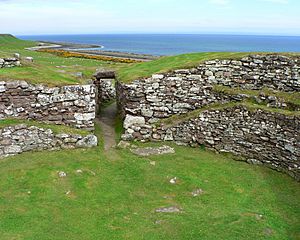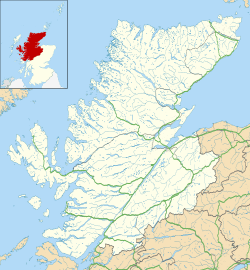Carn Liath (broch) facts for kids

Interior of Carn Liath
|
|
| Location | Scottish Highlands |
|---|---|
| Coordinates | 57°59′14″N 3°54′43″W / 57.987215°N 3.912052°W |
| Type | Broch |
| History | |
| Periods | Iron Age |
| Site notes | |
| Ownership | Historic Environment Scotland |
Càrn Liath (which means Grey Cairn in English) is a very old stone tower. These towers are called brochs. This one was built during the Iron Age. It stands on the eastern coast of the Scottish Highlands, close to a town called Golspie in Sutherland.
Contents
Where is Carn Liath Located?
This ancient broch is found near Golspie in Sutherland, Scotland. It is right next to the A9 road. You can find it about 4 kilometres (2.5 miles) northeast of Golspie. Historic Environment Scotland looks after the site. There is a car park and an information board for visitors to learn more.
What Does Carn Liath Look Like?
The Carn Liath broch is a large, circular stone tower. Its outer wall measures about 19 metres (62 feet) across. The inside space is about 10 metres (33 feet) wide. The walls of this broch are very thick.
The Entrance and Inside Features
The main entrance is on the east side. It is over 4 metres (13 feet) long. The entrance has special "door checks." These are stone slots that held a wooden door in place. There is also a "bar-hole." This was a hole in the wall where a strong wooden bar could slide across the entrance. This helped to keep people out. On the right side of the entrance passage, there is a small hidden room. This room is called a guard cell.
Buildings Around the Broch
Around the main broch tower, there was once an enclosure. This area contains the remains of other stone buildings. These buildings were likely used by the people who lived there.
Discoveries from Excavations
People have dug up the site of Carn Liath many times. This is called an excavation. It helps us learn about the past.
Early Digs in the 1800s
The first excavations happened in the 1800s. The Duke of Sutherland led these early digs. At first, people thought the site was a burial mound, which is called a cairn. During these digs, many interesting things were found. These included pieces of pottery and sharp flint chips. They also found stone hammers, tools for grinding food (like mortars and pestles, and querns). Other finds included whorls (used for spinning thread), shale rings, and long bone combs. A club made from whale bone was also discovered. Even a silver brooch and cups made of steatite (a soft stone) were found. An iron blade was also among the discoveries.
Later Discoveries
In 1909, the entrance passage of the broch was still easy to see. But by 1960, many of the original stone features were hard to spot.
The site was dug up again in 1986. This excavation showed that people lived here even before the broch was built. They found proof that the site was used during the Bronze Age. A Bronze Age cist burial was found. This is a stone box used for burying someone. It contained a special pot called a food vessel. The foundations of many smaller buildings were also found around the broch. Some of these buildings were built much later. But some might have been used at the same time as the broch.
See also
 In Spanish: Carn Liath para niños
In Spanish: Carn Liath para niños


